1995 CHEVROLET CAMARO fuel cap
[x] Cancel search: fuel capPage 127 of 388
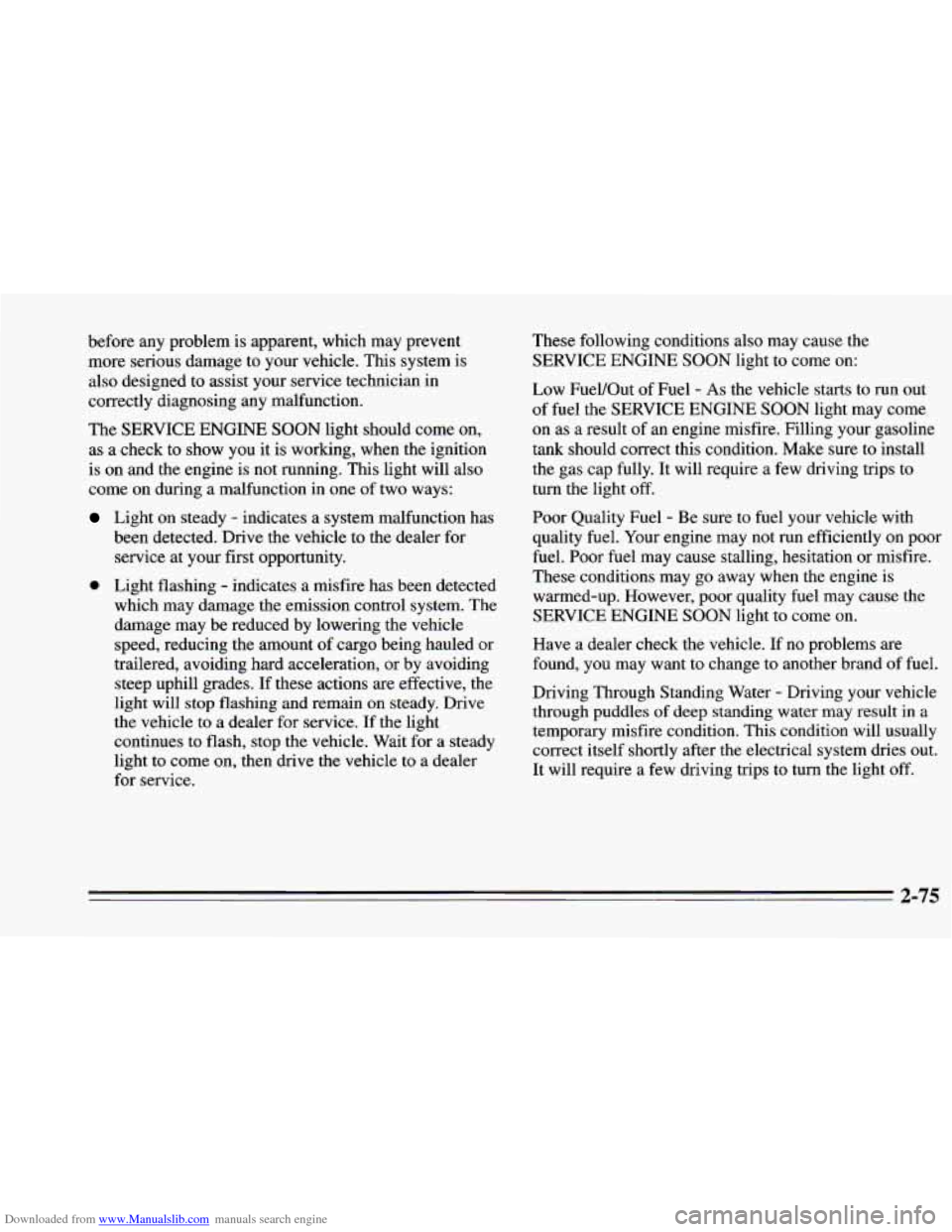
Downloaded from www.Manualslib.com manuals search engine before any problem is apparent, which may prevent
more serious damage to your vehicle. This system is
also designed to assist your service technician in
correctly diagnosing any malfunction.
The SERVICE ENGINE
SOON light should come on,
as a check to show you it is working, when the ignition
is on and the engine is not running. This light will also
come on during a malfunction in one of two ways:
Light on steady - indicates a system malfunction has
been detected. Drive the vehicle to the dealer for
service at your first opportunity.
0 Light flashing - indicates a misfire has been detected
which may damage the emission control system. The
damage may be reduced by lowering the vehicle
speed, reducing the amount of cargo being hauled or
trailered, avoiding hard acceleration, or
by avoiding
steep uphill grades. If these actions are effective, the
light will stop flashing and remain on steady. Drive
the vehicle to a dealer for service. If the light
continues to flash, stop the vehicle. Wait for
a steady
light to come on,
then drive the vehicle to a dealer
for service. These
following conditions also may cause the
SERVICE ENGINE SOON light to come on:
Low Fuel/Out of Fuel
- As the vehicle starts to run out
of fuel the SERVICE ENGINE SOON light may come
on as a result of an engine misfire. Filling your gasoline
tank should correct this condition. Make sure to install
the gas cap fully. It will require a few driving trips to
turn the light off.
Poor Quality Fuel
- Be sure to fuel your vehicle with
quality fuel. Your engine may not run efficiently on poor
fuel.
Poor fuel may cause stalling, hesitation or misfire.
These conditions may go away when the engine is
warmed-up. However, poor quality fuel may cause the
SERVICE ENGINE SOON light to come on.
Have a dealer check the vehicle. If
no problems are
found, you may want to change to another brand of fuel.
Driving Through Standing Water
- Driving your vehicle
through puddles
of deep standing water may result in a
temporary misfire condition. This condition will usually
correct itself shortly after the electrical system dries out.
It will require a few driving trips to turn the light off.
2-75
Page 131 of 388
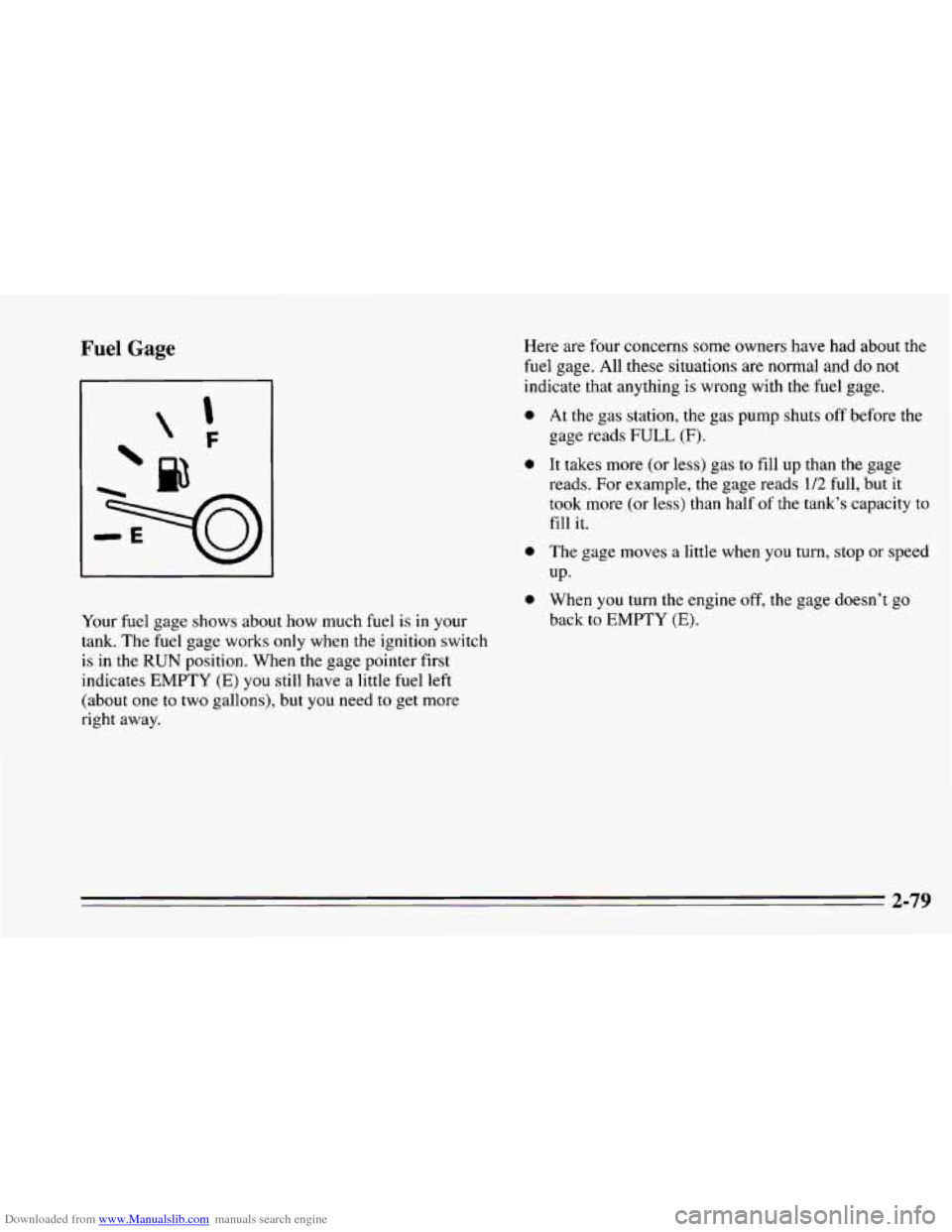
Downloaded from www.Manualslib.com manuals search engine Fuel Gage Here are four concerns some owners have had about the
fuel gage. All
these situations are normal and do not
indicate that anything is wrong with the fuel gage.
0
0
0
0
Your fuel gage shows about how much fuel is in your
tank. The fuel gage works only when the ignition switch
is in the RUN position. When the gage pointer first
indicates EMPTY
(E) you still have a little fuel left
(about
one to two gallons), but you need to get more
right away. At the
gas station,
the gas pump shuts off before the
gage reads
FULL (F).
It takes more (or less) gas to fill up than the gage
reads. For example, the gage reads 1/2 full, but
it
took more (or less) than half of the tank’s capacity to
fill
it.
The gage moves a little when you turn, stop or speed
UP.
When
you turn the engine off, the gage doesn’t PO
back to EMPTY (E),
Page 142 of 388
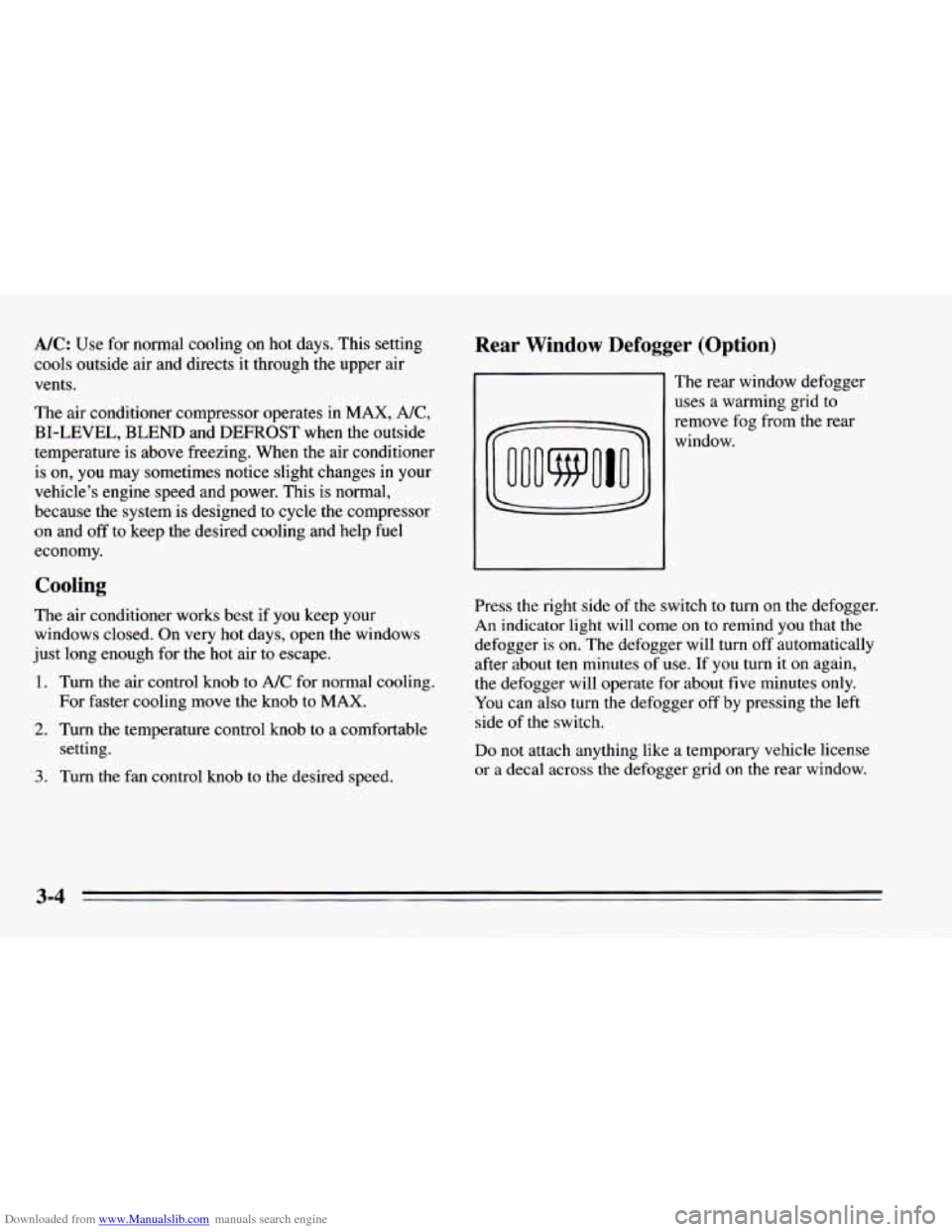
Downloaded from www.Manualslib.com manuals search engine A/C: Use for normal cooling on hot days. This setting
cools outside air and directs it through the upper air
vents.
The air conditioner compressor operates in
MAX, NC,
BI-LEVEL, BLEND and DEFROST when the outside
temperature
is above freezing. When the air conditioner
is on, you may sometimes notice slight changes in your
vehicle’s engine speed and power. This is normal,
because the system is designed to cycle the compressor
on and
off to keep the desired cooling and help fuel
economy.
Cooling
The air conditioner works best if you keep your
windows closed. On very hot days, open the windows
just long enough for the hot air to escape.
1. Turn the air control knob to A/C for normal coolinn.
For faster cooling move the knob to
MAX.
setting.
2. Turn the temperature control knob to a comfortable
3. Turn the fan control knob to the desired speed.
Rear Window Defogger (Option)
The rear window defogger
uses a warming grid to
remove fog
from the rear
window.
Press the right side of the switch to turn
on the defogger.
An indicator light will come on to remind you that the
defogger is on. The defogger will
turn off automatically
after about ten minutes of use.
If you turn it on again,
the defogger will operate for about five minutes only.
You can also turn the defogger
off by pressing the left
side of the switch.
Do not attach anything like a temporary vehicle license
or a decal across the defogger grid on the rear window.
3-4
Page 185 of 388
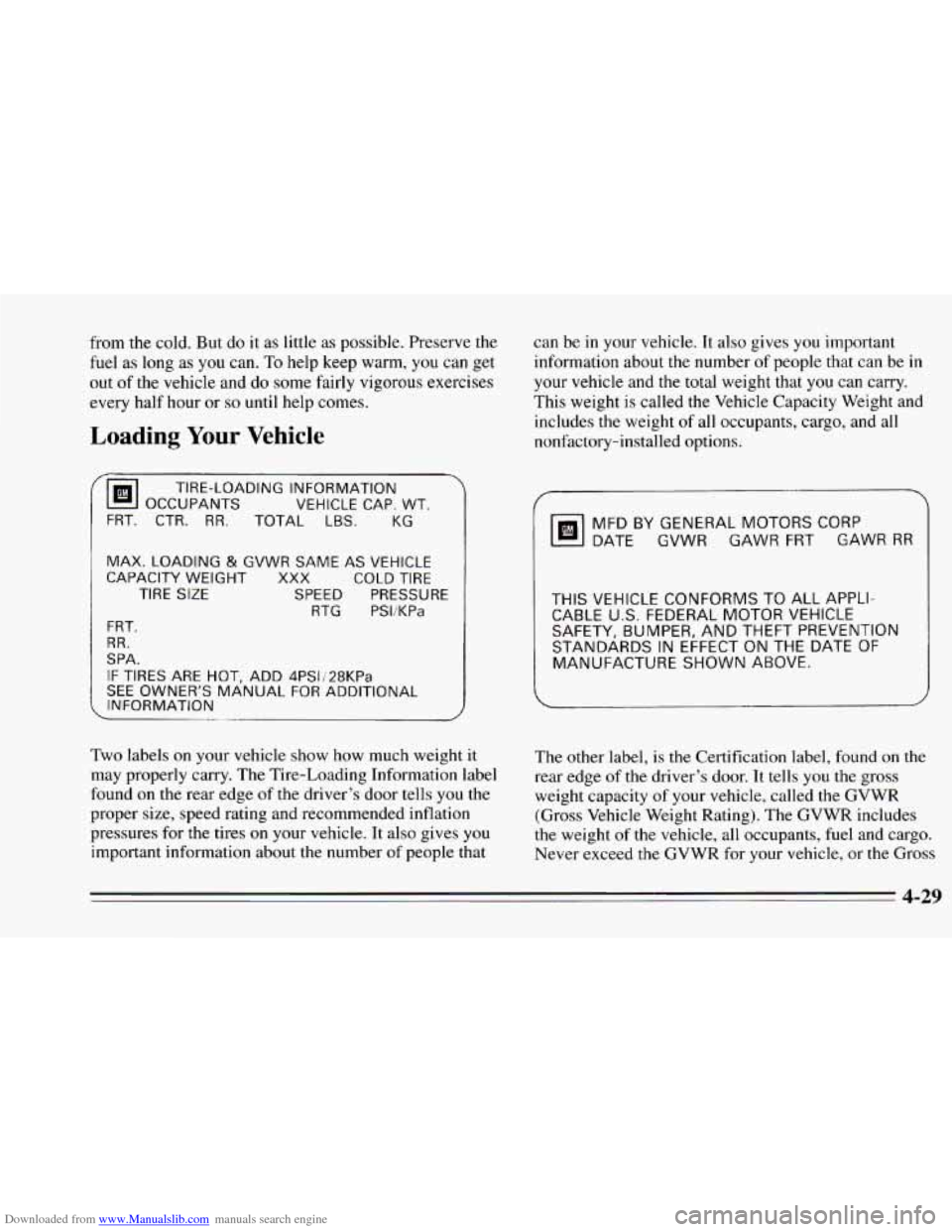
Downloaded from www.Manualslib.com manuals search engine from the cold. But do it as little as possible. Preserve the
fuel as long as you can.
To help keep warm, you can get
out
of the vehicle and do some fairly vigorous exercises
every half hour or
so until help comes.
Loading Your Vehicle
can be in your vehicle. It also gives you important
information about
the number of people that can be in
your vehicle and
the total weight that you can carry.
This weight is called the Vehicle Capacity Weight and
includes the weight of all occupants, cargo, and all
nonfactory-installed options.
OCCUPANTS
VEHICLE CAP. WT.
TIRE-LOADING INFORMATION
FRT.
CTR. RR. TOTAL LBS. KG
MAX. LOADING & GVWR SAME AS VEHICLE
CAPACITY WEIGHT XXX COLD TIRE
TIRE SIZE SPEED PRESSURE
RTG PSliKPa
FRT.
RR.
SPA.
IF TIRES ARE HOT. ADD 4PSIi28KPa
SEE OWNER‘S MANUAL FOR ADDITIONAL
INFORMATION
MFDBYGENERALMOTORSCORP
DATE GVWR GAWR FRT GAWR
RR
THIS VEHICLE CONFORMS TO ALL APPLI-
CABLE U.S. FEDERAL MOTOR VEHICLE
SAFETY, BUMPER, AND THEFT PREVENTION
STANDARDS
IN EFFECT ON THE DATE OF
MANUFACTURE SHOWN ABOVE.
Two labels on your vehicle show how much weight it
may properly carry. The Tire-Loading Information label
found
on the rear edge of the driver’s door tells you the
proper size, speed rating and recommended inflation
pressures for the tires
on your vehicle. It also gives you
important information about the number of people that The other label,
is the
Certification label, found on the
rear edge of the driver’s door. It tells you the gross
weight capacity of your vehicle, called the GVWR
(Gross Vehicle Weight Rating). The GVWR includes
the weight
of the vehicle, all occupants, fuel and cargo.
Never exceed the GVWR for your vehicle, or the Gross
4-29
Page 187 of 388
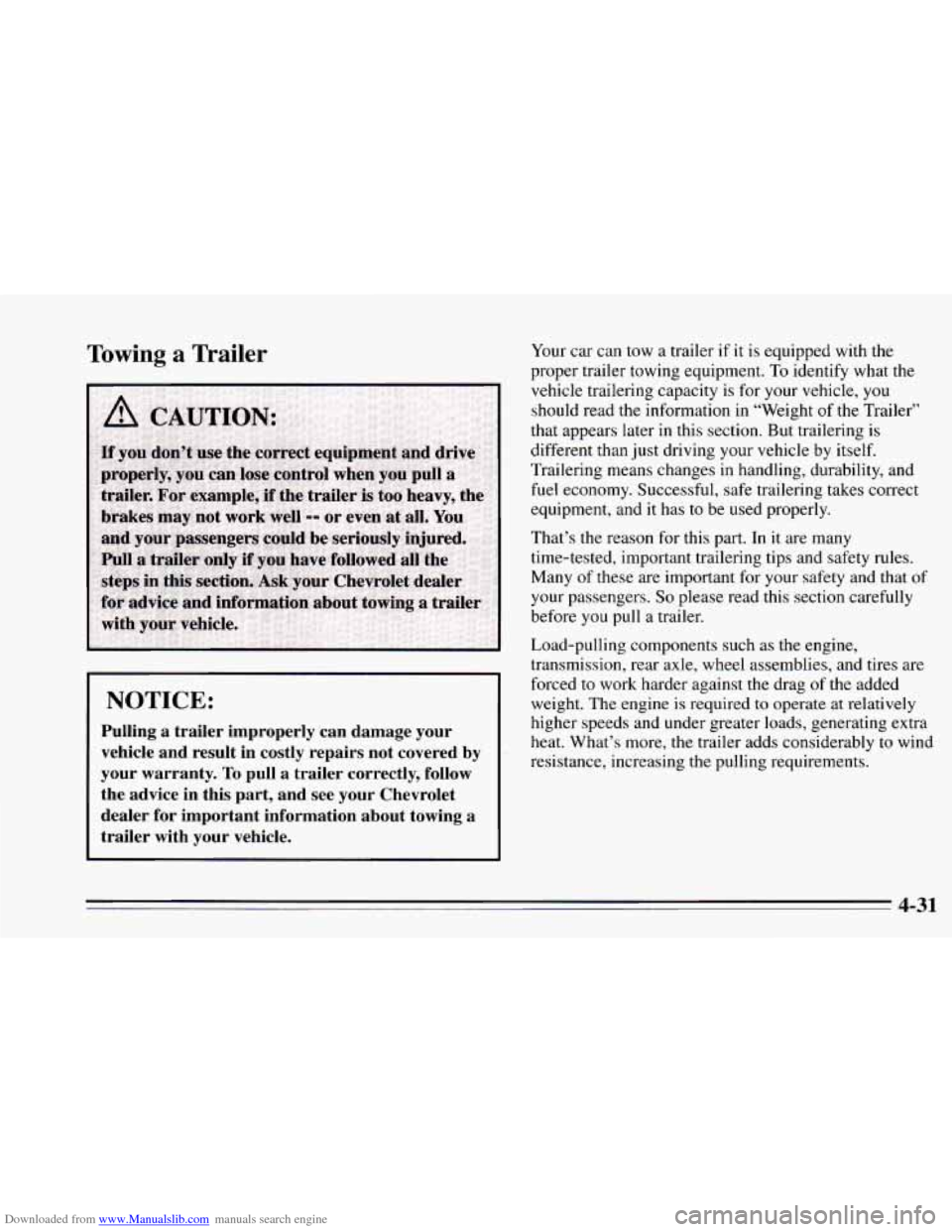
Downloaded from www.Manualslib.com manuals search engine Towing a Trailer
NOTICE:
Pulling a trailer improperly can damage your
vehicle and result in costly repairs not covered
by
your warranty. To pull a trailer correctly, follow
the advice in this part, and see your Chevrolet
dealer for important information about towing a
trailer with your vehicle.
Your car can tow a trailer if it is equipped with the
proper trailer towing equipment. To identify what the
vehicle trailering capacity is for your vehicle,
you
should read the information in “Weight of the Trailer”
that appears later
in this section. But trailering is
different than just driving your vehicle by itself.
Trailering means changes in handling, durability, and
fuel economy. Successful, safe trailering takes correct
equipment, and
it has to be used properly.
That’s the reason for this part. In
it are many
time-tested, important trailering tips and safety rules.
Many of these are important for your safety and that
of
your passengers. So please read this section carefully
before you pull a trailer.
Load-pulling components such as the engine,
transmission, rear axle, wheel assemblies, and tires are
forced to work harder against the drag
of the added
weight. The engine
is required to operate at relatively
higher speeds and under greater loads, generating extra
heat. What’s more, the trailer adds considerably
to wind
resistance, increasing the pulling requirements.
4-31
Page 238 of 388
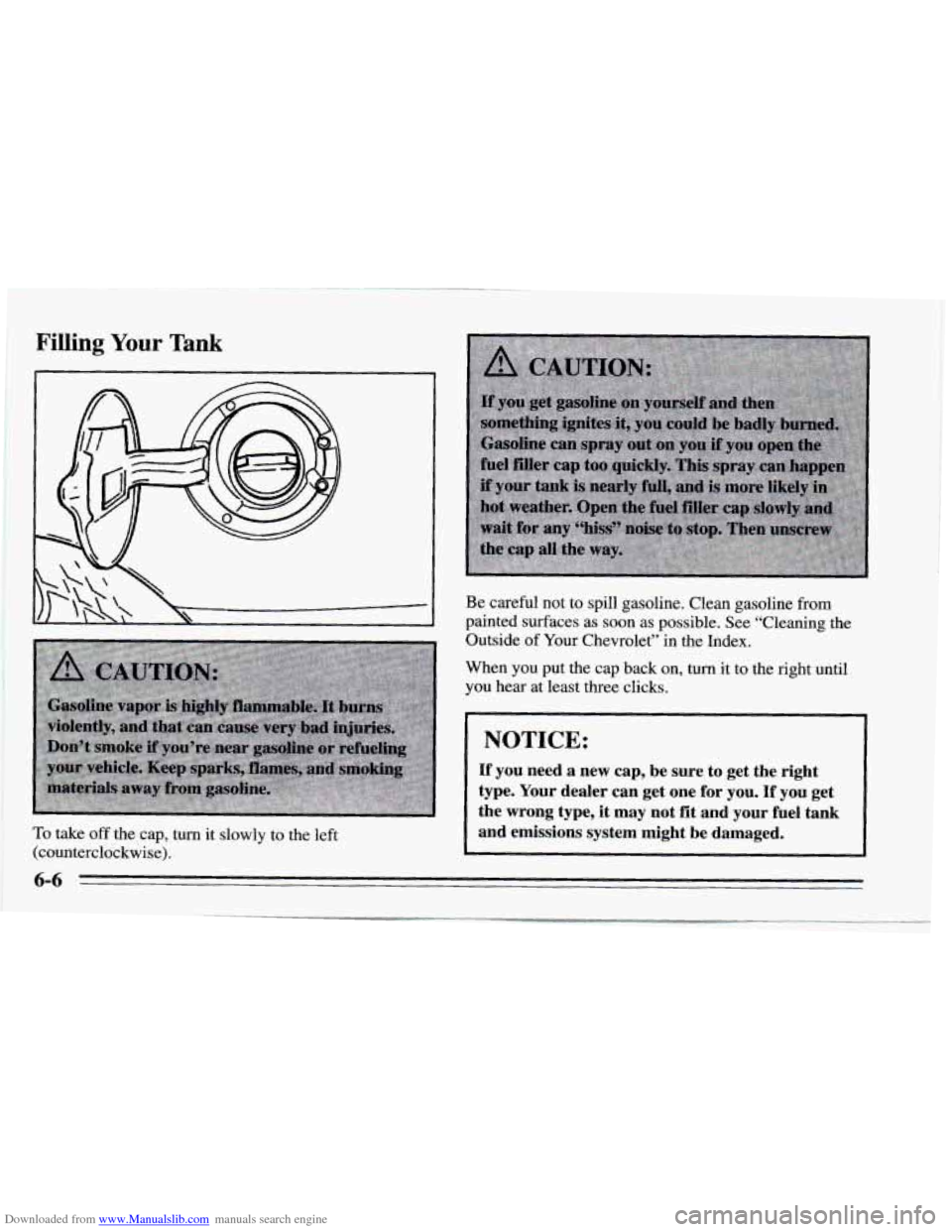
Downloaded from www.Manualslib.com manuals search engine Filling Your Tank
To take off the cap, turn it slowly to the left
(counterclockwise). Be careful not
to spill gasoline. Clean gasoline from
painted surfaces as soon as possible. See “Cleaning
the
Outside of Your Chevrolet” in the Index.
When
you put the cap back on, turn it to the right until
you hear at least three clicks.
NOTICE:
If you need a new cap, be sure to get the right
type. Your dealer can get one for you.
If you get
the wrong type, it may not fit and your fuel tank and emissions system might be damaged.
6-6
Page 243 of 388
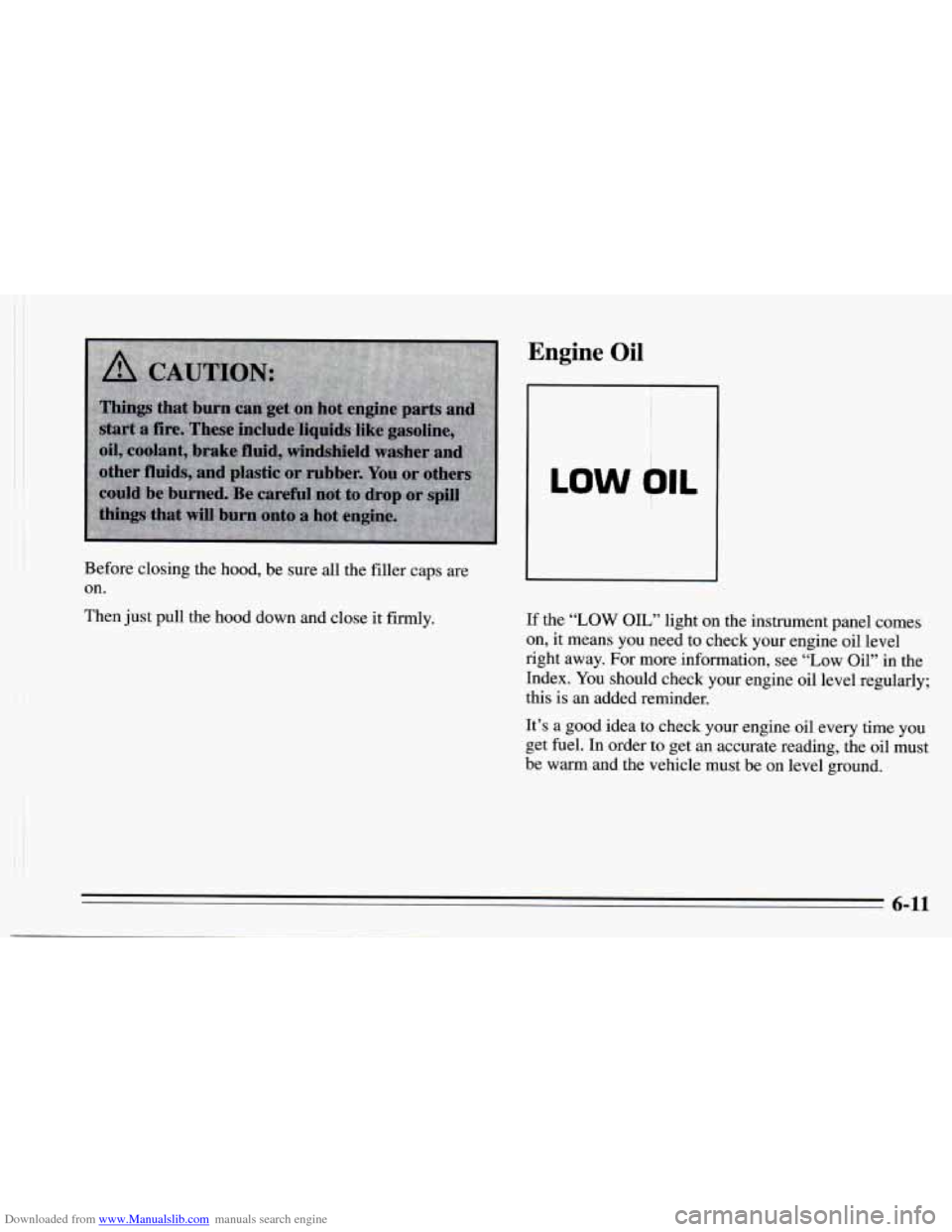
Downloaded from www.Manualslib.com manuals search engine Then just pull the hood down and close it firmly.
Before closing
the hood, be sure
all the filler caps are
on.
Engine Oil
LOW blL
If the “LOW OIL” light on the instrument panel comes
on, it means you need to check your engine oil level
right away. For more information, see “Low Oil”
in the
Index. You should check your engine oil level regularly;
this is an added reminder.
It’s
a good idea to check your engine oil every time you
get
fuel. In order to get an accurate reading, the oil must
be warm and the vehicle must be on level ground.
6-11
Page 306 of 388

Downloaded from www.Manualslib.com manuals search engine Capacities and Specifications
Engine
Type VIN Engine Code
S and K ................... V6
VIN Engine Code
P ........................ V8
Fuel Delivery
...................... Fuel Injection
Valve Arrangement
...................... In-Head
Piston Displacement
VIN Engine Code
S .............. 207 CID (3.4L)
VIN Engine Code
K .............. 23 1 CID (3.8L)
VIN Engine Code
P .............. 350 CID (5.7L)
VIN Engine Code
S and K ................. 9.0: I
VIN Engine Code P ..................... 10.5: 1
VIN Engine Code S and K ........... 1-6-5-4-3-2
VIN Engine Code
P ............ 1-8-4-3-6-5-7-2
Compression Ratio
Firing Order
Wheel Nuts
Wheel Nut Torque ... 100
Ib. ft. (I 40 N-m)
Capacities (Approximate)
The following approximate capacities are given in U.S.
and metric conversions.
Air Conditioning?
..... See the refrigerant information
label under the hood.
Automatic Transmission
Drain and Refill
.................. IO pt. (4.7 L)*
VIN Engine Code S and K . . , . . , . . 17.6 pt. (8.3 L)*
VIN Engine Code P ............ 2 1.6 pt. (1 0.2 L)*
VIN Engine Code S
Overhaul
Cooling System
With Manual Transmission
...... 12.5 qt. (1 1.8 L)
With Automatic Transmission
, . . , 12.3 qt. (1 1.6 L)
With Manual Transmission
...... 12.5 qt. (1 1.8 L)
With Automatic Transmission .... 12.3 qt. (1 I .6 L)
With Manual Transmission ...... 15.3 qt. (14.5 L)
With Automatic Transmission
.... 15.1 qt. (14.3 L)
VIN
Engine Code
K
VIN Engine Code P
6-74